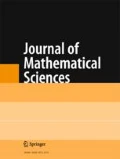We prove that an open, proper, nonempty subset of \({\mathbb{R}}^n\) is a locally Lyapunov domain if and only if it satisfies a uniform hour-glass condition. The limiting cases are as follows: Lipschitz domains may be characterized by a uniform double cone condition, and domains of class  may be characterized by a uniform two-sided ball condition. We discuss a sharp generalization of the Hopf–Oleinik boundary point principle for domains satisfying an interior pseudoball condition, for semi-elliptic operators with singular drift and obtain a sharp version of the Hopf strong maximum principle for second order, nondivergence form differential operators with singular drift. Bibliography: 66 titles. Illustrations: 7 figures.
may be characterized by a uniform two-sided ball condition. We discuss a sharp generalization of the Hopf–Oleinik boundary point principle for domains satisfying an interior pseudoball condition, for semi-elliptic operators with singular drift and obtain a sharp version of the Hopf strong maximum principle for second order, nondivergence form differential operators with singular drift. Bibliography: 66 titles. Illustrations: 7 figures.
Similar content being viewed by others
References
D. S. Jerison and C. E. Kenig, “Boundary behavior of harmonic functions in nontangentially accessible domains,” Adv. Math. 46, No. 1, 80–147 (1982).
P. W. Jones, “Quasiconformal mappings and extendability of functions in Sobolev spaces,” Acta Math. 47, 71–88 (1981).
G. David and S. Semmes, “Singular Integrals and Rectifiable Sets in \({\mathbb{R}}^n\): Beyond Lipschitz Graphs,” Astérisque, No. 193 (1991).
S. Hofmann, M. Mitrea, and M. Taylor, “Singular integrals and elliptic boundary problems on regular Semmes-Kenig-Toro domains,” Int. Math. Res. Not. No. 14, 2567–2865 (2010).
S. Hofmann, M. Mitrea, and M. Taylor, “Geometric and transformational properties of Lipschitz domains, Semmes-Kenig-Toro domains, and other classes of finite perimeter domains,” J. Geom. Anal. 17, No. 4, 593–647 (2007).
N. M. Gunther, La Théorie du Potentiel et ses Applications aux Problèmes Fondamentaux de la Physique Mathématique, Gauthier-Villars, Paris (1934).
N. M. Gunther, Potential Theory, Ungar, New York (1967).
D. Gilbarg and N. Trudinger, Elliptic Partial Differential Equations of Second Order, Springer, Berlin etc. (1983).
P. Pucci and J. Serrin, The Maximum Principle, Birkhäuser, Basel etc. (2007).
M. S. Zaremba, “Sur un problème mixte relatif à l’équation de Laplace,” Bull. Int. l’Acad. Sci. Cracovie, Série A, Class Math. Nat., 313–344 (1910).
E. Hopf, “A remark on linear elliptic differential equations of second order,” Proc. Am. Math. Soc. 3, 791–793 (1952).
O. A. Oleinik, “On properties of solutions of certain boundary problems for equations of elliptic type” [in Russian], Mat. Sb., N. Ser. No. 30(72), 695–702 (1952).
A. V. Bitsadze, Boundary Value Problems for Second Order Elliptic Equations, North-Holland, Amsterdam (1968).
M. E. Taylor, Partial Differential Equations. 1: Basic Theory, Springer, Berlin (1996).
L. C. Evans and R. F. Gariepy, Measure Theory and Fine Properties of Functions, CRC Press, Boca Raton, FL (1992).
W. Ziemer, Weakly Differentiable Functions, Springer, New York (1989).
S. Alexander, “Local and global convexity in complete Riemannian manifolds,” Pac. J. Math. 76, No. 2, 283–289 (1978).
P. Grisvard, Elliptic Problems in Nonsmooth Domains Pitman, Boston etc. (1985).
N. S. Nadirashvili, “Lemma on the interior derivative and uniqueness of the solution of the second boundary value problem for second order elliptic equations” [in Russian], Dokl. Akad. Nauk SSSR 261, No. 4, 804–808 (1981); English transl.: Sov. Math., Dokl. 24, 598–601 (1981).
E. J. McShane, “Extension of range of functions,” Bull. Am. Math. Soc. 40, 837–842 (1934).
H. Whitney, “Analytic extensions of functions defined on closed sets,” Trans. Am. Math. Soc. 36, 63–89 (1934).
D. Gilbarg, “Some hydrodynamic applications of function theoretic properties of elliptic equations,” Math. Z. 72, No. 1, 165–174 (1959).
A. I. Nazarov, A Centennial of the Zaremba–Hopf–Oleinik Lemma, Preprint (2010); arXiv:1101.0164v1
R. Finn and D. Gilbarg, “Asymptotic behavior and uniqueness of plane subsonic flows,” Commun. Pure Appl. Math. 10, No. 1, 23–63 (1957).
C. Neumann, “Über die Methode des Arithmetischen Mittels,” Abhand. Königl. Sächs. Ges. Wiss., Leipzig, 10, 662–702 (1888).
A. Korn, Lehrbuch der Potentialtheorie. II. Allgemeine Theorie des logarithmischen Potentials und der Potentialfunctionen in der Ebene, F. Dümmler., Berlin (1901).
L. Lichtenstein, “Neue Beiträge zur Theorie der linearen partiellen Differentialgleichungen zweiter Ordnung vom elliptischen Typus,” Math. Zeitschr. 20, 194–212 (1924).
G. Giraud, “Generalisation des probl`emes sur les op´erations du type elliptique,” Bull. Sci. Math. 56, 316–352 (1932).
G. Giraud, “Problèmes de valeurs à la frontière rèlatifs à certaines données discontinues,” Bull. Soc. Math. Fr. 61, 1–54 (1933).
C. Miranda, Partial Differential Equations of Elliptic Type Springer, New York etc. (1970).
M. Keldysch and M. Lavrentiev, “Sur l’unicité de la solution du problème de Neumann,” C. R. (Dokl.) Acad. Sci. URSS 16, No. 3, 141–142 (1937).
V. A. Kondrat’ev and E. M. Landis, “Qualitative theory of second order linear partial differential equations,” Partial Differential Equations III. Encycl. Math. Sci. 32, 87–192 (1991).
M. V. Safonov, Boundary Estimates for Positive Solutions to Second Order Elliptic Equations, Preprint (2008).
L. I. Kamynin, “A theorem on the internal derivative for a weakly degenerate second order elliptic equation” [in Russian], Mat. Sb., Nov. Ser. 126(168), No. 3, 307–326 (1985); English transl.: Math. USSR, Sb. 54, No. 2, 297–316 (1986).
E. Hopf, “Elementare Bemerkung über die Lösung partieller Differentialgleichungen zweiter Ordnung vom elliptischen Typus,” Sitzungsberichte Akad. Berlin, 147–152 (1927).
D. Gilbarg, “Uniqueness of axially symmetric flows with free boundaries,” J. Ration. Mech. Anal. 1, 309–320 (1952).
E. M. Landis, Second Order Equations of Elliptic Type and Parabolic Type Am. Math. Soc., Providence, RI (1998).
L. C. Evans, Partial Differential Equations, Am. Math. Soc., Providence, RI (1998).
L. E. Fraenkel, An Introduction to Maximum Principles and Symmetry in Elliptic Problems, Cambridge Univ. Press, Cambridge (2000).
M. H. Protter and H. F. Weinberger, Maximum Principles in Differential Equations, Prentice-Hall, Inc., Englewood Cliffs, NJ (1967).
A. D. Aleksandrov, “Investigations on the maximum principle. I” [in Russian], Izv. Vyssh. Uchebn. Zaved. Mat. No. 5(6), 126–157 (1958).
A. D. Aleksandrov, “Investigations on the maximum principle. II” [in Russian], Izv. Vyssh. Uchebn. Zaved. Mat. No. 3(10), 3–12 (1959).
A. D. Aleksandrov, “Investigations on the maximum principle. III” [in Russian], Izv. Vyssh. Uchebn. Zaved. Mat. No. 5(12), 16–32 (1959).
A. D. Aleksandrov, “Investigations on the maximum principle. IV” [in Russian], Izv. Vyssh. Uchebn. Zaved. Mat. No. 3(16), 3–15 (1960).
A. D. Aleksandrov, “Investigations on the maximum principle. V” [in Russian], Izv. Vyssh. Uchebn. Zaved. Mat. No. 5(18), 16–26 (1960).
A. D. Aleksandrov, “Investigations on the maximum principle. VI” [in Russian], Izv. Vyssh. Uchebn. Zaved. Mat. No. 1(20), 3–20 (1961).
L. I. Kamynin and B. N. Khimchenko, “On theorems of Giraud type for a second order elliptic operator weakly degenerate near the boundary” [in Russian], Dokl. Akad. Nauk SSSR 224, No. 4, 752–755 (1975); English transl.: Sov. Math., Dokl. 16, No. 5, 1287–1291 (1975).
L. I. Kamynin and B. N. Khimchenko, “The maximum principle for an elliptic-parabolic equation of the second order” [in Russian], Sib. Mat. Zh. 13, 773–789 (1972); English transl.: Sib. Math. J. 13, 533–545 (1973).
L. I. Kamynin and B. N. Khimchenko, “Theorems of the Giraud type for second order equations with weakly degenerate nonnegative characteristic part” [in Russian], Sib. Mat. Zh. 18, No. 1, 103–121 (1977); English transl.: Sib. Math. J. 18, 76–91 (1977).
L. I. Kamynin and B. N. Khimchenko, “Investigations of the maximum principle,” Dokl. Akad. Nauk SSSR 240, No. 4, 774–777 (1978); English transl.: Sov. Math., Dokl. 19, 677–681 (1978).
R. Výborný, “On certain extensions of the maximum principle,” In: Differential Equations and their Applications, Proc. Copnf. Prague Sept. 1962, pp. 223–228, Academic Press, New York (1963).
L. I. Kamynin and B. N. Khimchenko, “Development of Aleksandrov’s theory of the isotropic strict extremum principle” [in Russian], Differ. Uravn. 16, No. 2, 280–292 (1980); English transl.: Differ. Equations 16, No. 2, 181–189 (1980).
C. Pucci, “Proprietà di massimo e minimo delle soluzioni di equazioni a derivate parziali del secondo ordine di tipo ellittico e parabolico. I,” Atti Accad. Naz. Lincei. Rend. Cl. Sci. Fis. Mat. Nat., (8) 23, No. 6, 370–375 (1957).
C. Pucci, “Proprietà di massimo e minimo delle soluzioni di equazioni a derivate parziali del secondo ordine di tipo ellittico e parabolico. II,” Atti Accad. Naz. Lincei. Rend. Cl. Sci. Fis. Mat. Nat., (8) 24, No. 1, 3–6 (1958).
G. M. Lieberman, “Regularized distance and its applications,” Pac. J. Math. 117, No. 2, 329–352 (1985).
A. I. Nazarov and N. N. Ural’tseva, Qualitative Properties of Solutions to Elliptic and Parabolic Equations with Unbounded Lower Order Coefficients, Preprint (2009).
A. I. Nazarov and N. N. Ural’tseva, The Harnack Inequality and Related Properties for Solutions to Elliptic and Parabolic Equations with Divergence-Free Lower Order Coefficients [in Russian], Algebra Anal. 23, No. 1, 136–168 (2011); English transl.: St. Petersburg Math. J. 23, No. 1 (2012). [To appear]
M. V. Safonov, “Non-divergence elliptic equations of second order with unbounded drift,” In: Nonlinear Partial Differential Equations and Related Topic, pp. 211–232. Am. Math. Soc., Providence, RI (2010).
L. Nirenberg, “A strong maximum principle for parabolic equations,” Commun. Pure Appl. Math. 6, 167–177 (1953).
L. I. Kamynin, “A theorem on the internal derivative for a second order uniformly parabolic equation” [in Russian], Dokl. Akad. Nauk SSSR 299, No. 2, 280–283 (1988); English transl.: Sov. Math., Dokl. 37, No. 2, 373–376 (1988).
L. I. Kamynin and B. N. Khimchenko, “The analogues of the Giraud theorem for a second order parabolic equation” [in Russian], Sib. Mat. Zh. 14, No. 1, 86–110 (1973); English transl.: Sib. Math. J. 14, 59–77 (1973).
L. I. Kamynin and B. N. Khimchenko, “An aspect of the development of the theory of the anisotropic strict A. D. Aleksandrov extremum principle” [in Russian], Differ. Uravn. 19, No. 3, 426–437 (1983); English transl.: Differ. Equations 19, No. 3, 318–327 (1983).
A. Carbery, V. Maz’ya, M. Mitrea, and D. J. Rule, The Integrability of Negative Powers of the Solution of the Saint Venant Problem, Preprint (2010).
A. Ancona, “On strong barriers and an inequality of Hardy for domains in \({\mathbb{R}}^n\),” J. London Math. Soc. (2) 34, 247–290 (1986).
R. T. Rockafellar, Convex Analysis, Princeton Univ. Press, Princeton, NJ (1970).
C. S. Morawetz, J. B. Serrin, and Y. G. Sinai, Selected Works of Eberhard Hopf with Commentaries, Am. Math. Soc., Providence, RI (2002).
Author information
Authors and Affiliations
Corresponding author
Additional information
Translated from Problems in Mathematical Analysis 57, May 2011, pp. 3–68.
Rights and permissions
About this article
Cite this article
Alvarado, R., Brigham, D., Maz’ya, V. et al. On the regularity of domains satisfying a uniform hour–glass condition and a sharp version of the Hopf–Oleinik boundary point principle. J Math Sci 176, 281–360 (2011). https://doi.org/10.1007/s10958-011-0398-3
Received:
Published:
Issue Date:
DOI: https://doi.org/10.1007/s10958-011-0398-3



